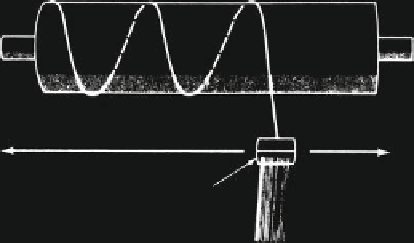Biomedical Engineering Reference
In-Depth Information
devices, such as bone plates and screws, at much lower
cost than comparable metallic devices.
Continuous pultrusion is a process used for the man-
ufacture of fiber-reinforced plastics of constant cross
section such as structural shapes, beams, channels, pipe,
and tubing. In this process, continuous-strand fibers are
impregnated in a resin bath and then are drawn through
a heated die, which determines the shape of the finished
stock (
Fig. 3.2.12-3
). Highly oriented parts cut from this
stock can then be used in other structures or they can be
used alone in such applications as intramedullary rodding
or pin fixation of bone fragments.
Mandrel
Traversing
carriage
Resin-impregnated
fibers
Fig. 3.2.12-2 Filament-winding process for producing fiber-
reinforced composite materials.
Mechanical and physical properties
of composites
In this process, the fiber reinforcement is fed through
a resin bath and then wound on a suitable mandrel
(
Fig. 3.2.12-2
). When sufficient layers have been applied,
the wound mandrel is cured. The molded part is then
stripped from the mandrel. The high degree of fiber
orientation and high fiber loading with this method
produce extremely high tensile strengths. Biomedical
applications for this process include intramedullary rods
for fracture fixation, prosthetic hip stems, ligament
prostheses, intervertebral disks, and arterial grafts.
Continuous fiber composites
Laminated continuous fiber-reinforced composites are
described from either a micro- or macromechanical point
of view. Micromechanics is the study of composite ma-
terial behavior wherein the interaction of the constituent
materials is examined on a local basis. Macromechanics is
the study of composite material behavior wherein the
material is presumed homogeneous and the effects of the
constituent materials are detected only as averaged ap-
parent properties of the composite. Both the micro-
mechanics
Closed-mold processes
There are many closed-mold methods used for producing
fiber-reinforced plastic materials. The methods of most
importance to biomedical composites are compression
and injection molding and continuous pultrusion. In
compression molding, the previously described prepregs
are arranged in a two-piece mold that is then heated
under pressure to produce the laminated part. This
method is particularly useful for use with thermoplastic
matrices. In injection molding the fiber-matrix mix is
injected into a mold at elevated temperature and pres-
sure. The finished part is removed after cooling. This is
an extremely fast and inexpensive technique that has
application to chopped fiber-reinforced thermoplastic
composites. It offers the possiblity to produce composite
and
macromechanics
of
experimental
laminated composites will be discussed.
Micromechanics
There are two basic approaches to the micromechanics
of composite materials: the mechanics of materials and
the elasticity approach. The mechanics-of-materials ap-
proach embodies the concept of simplifying assump-
tions regarding the hypothesized behavior of the
mechanical system. It is the simpler of the two and
the traditional choice for micromechanical evaluation.
Orientation
Heated
die
Pull rollers
Resin dip
tank
Reinforcement
supply
Fig. 3.2.12-3 The pultrusion process for producing fiber-reinforced polymer composite materials. Fibers impregnated with polymer are
fed into a heated die and then are slowly drawn out as a cured composite material with a constant cross-sectional shape.









